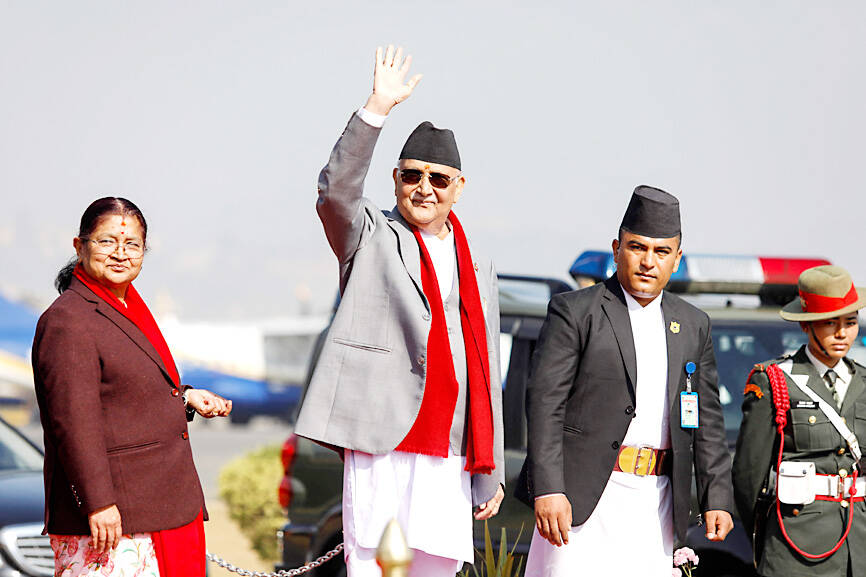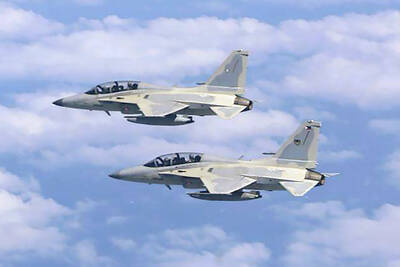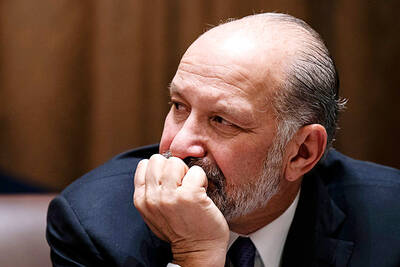Nepalese Prime Minister Khadga Prasad Sharma Oli was in Beijing yesterday to meet Chinese leaders, seeking to expand infrastructure cooperation after breaking with the longstanding tradition of new leaders making their first official visit to neighboring India.
Oli, who returned to power in July after two previous terms in the top job, arrived in Beijing to commence the trip on Monday evening, China Central Television footage showed.
The leader of the Himalayan republic is scheduled to meet with Chinese President Xi Jinping (習近平) and Chinese Premier Li Qiang (李強) during his visit, which is scheduled to last until tomorrow.

Photo: AFP
The Chinese Ministry of Foreign Affairs last week said that Xi and Oli would “have in-depth exchanges of views on deepening our traditional friendship.”
That includes expanding cooperation under the Belt and Road Initiative — Xi’s flagship international infrastructure project — and “exchanges and cooperation in various fields,” ministry spokeswoman Mao Ning (毛寧) said.
Pradeep Gyawali, deputy secretary of Oli’s Communist Party of Nepal Unified Marxist-Leninist, said that the visit would center on prior investment deals — including for the recently finished construction of an international airport in tourist hub Pokhara.
Oli has sought to walk a fine line between neighbors China and India, the world’s two most populous nations, but has favored Beijing in an effort to cut Kathmandu’s historical reliance on New Delhi.
Nepalese media reported that Oli likely chose Beijing as his first destination due to the absence of a formal invitation from New Delhi.
The Nepalese Ministry of Foreign Affairs said that Oli would “exchange views on matters of mutual interest” with his Chinese counterparts during the trip.
He was also to deliver a keynote address at Peking University and speak at a bilateral business forum, the Nepalese ministry said.

OPTIMISTIC: A Philippine Air Force spokeswoman said the military believed the crew were safe and were hopeful that they and the jet would be recovered A Philippine Air Force FA-50 jet and its two-person crew are missing after flying in support of ground forces fighting communist rebels in the southern Mindanao region, a military official said yesterday. Philippine Air Force spokeswoman Colonel Consuelo Castillo said the jet was flying “over land” on the way to its target area when it went missing during a “tactical night operation in support of our ground troops.” While she declined to provide mission specifics, Philippine Army spokesman Colonel Louie Dema-ala confirmed that the missing FA-50 was part of a squadron sent “to provide air support” to troops fighting communist rebels in

ECONOMIC DISTORTION? The US commerce secretary’s remarks echoed Elon Musk’s arguments that spending by the government does not create value for the economy US Secretary of Commerce Howard Lutnick on Sunday said that government spending could be separated from GDP reports, in response to questions about whether the spending cuts pushed by Elon Musk’s Department of Government Efficiency could possibly cause an economic downturn. “You know that governments historically have messed with GDP,” Lutnick said on Fox News Channel’s Sunday Morning Futures. “They count government spending as part of GDP. So I’m going to separate those two and make it transparent.” Doing so could potentially complicate or distort a fundamental measure of the US economy’s health. Government spending is traditionally included in the GDP because

Two daughters of an Argentine mountaineer who died on an icy peak 40 years ago have retrieved his backpack from the spot — finding camera film inside that allowed them a glimpse of some of his final experiences. Guillermo Vieiro was 44 when he died in 1985 — as did his climbing partner — while descending Argentina’s Tupungato lava dome, one of the highest peaks in the Americas. Last year, his backpack was spotted on a slope by mountaineer Gabriela Cavallaro, who examined it and contacted Vieiro’s daughters Guadalupe, 40, and Azul, 44. Last month, the three set out with four other guides

Sri Lanka’s fragile economic recovery could be hampered by threatened trade union strikes over reduced benefits for government employees in this year’s budget, the IMF said yesterday. Sri Lankan President Anura Kumara Dissanayake’s maiden budget raised public sector salaries, but also made deep cuts to longstanding perks in a continuing effort to repair the island nation’s tattered finances. Sri Lanka’s main doctors’ union is considering a strike from today to protest against cuts to their allowances, while teachers are also considering stoppages. IMF senior mission chief for Sri Lanka Peter Breuer said the budget was the “last big push” for the country’s austerity